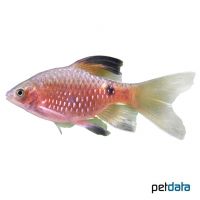Long Fin Rosy Barb (Pethia conchonius 'Long Fin')
| Long Fin Rosy Barb Pethia conchonius 'Long Fin' | |
|---|---|
| Name | Long Fin Rosy Barb |
| Name Lat. | Pethia conchonius 'Long Fin' |
| Synonym | Barbus conchonius |
| Family | Carps |
| Family lat. | Cyprinidae |
| Order | Carps |
| Order lat. | Cypriniformes |
| Origin | South Asia |
| Habitat | Streams, tributaries, lakes |
| Diet | Omnivore |
| pH | 6.0-8.0 |
| Behavior | Peaceful |
| Keeping | Group |
| Care Level | Easy |
| Reproduction | Egg scatterer |
| Breeding | Simple |
| Life Span | 4-6 years |
| Protection | No |
| Metric Units | |
| Size | 8 cm |
| Temperature | 18-24 °C |
| Hardness | 5-20 °dH |
| Aquarium | 100 l |
| US Units | |
| Size | 3" |
| Temperature | 64-75 °F |
| Hardness | 89-356 ppm |
| Aquarium | 25 gal |
Distribution and habitat
The veil splendor barb is a breeding form. The wild form is common in river systems in the northern Near East. They live in both mountain streams and tributaries, lakes and residual pools with root, gravel and stone covered bottoms and dense riparian vegetation.
Maintenance
The aquarium should have a dense border planting, with many hiding and retreat possibilities (roots, stones) and offer sufficient swimming space. With shaded light (floating plant cover) and a dark substrate covered with some foliage (e.g. sea almond leaves) they show the most beautiful coloration.
No ammonia, ammonium and nitrite should be detectable, the nitrate value should not exceed 100 mg/l. To ensure the water quality and oxygen content, a filter and heater adapted to the aquarium size is required, as well as lighting for the species-appropriate day-night rhythm of the animals.
Diet
The food supply consists of live, frozen and dry food. For a balanced diet, feed them once a day with a high-quality dry food (flakes, granules, pellets) as well as cyclops, daphnia or mosquito larvae (live or frozen). In addition, they need regular vegetable food, such as pureed leafy and wild vegetables or dry food with vegetable ingredients (e.g. spirulina)
It is recommended to feed small portions several times a day. Only feed as much as will be eaten within a few minutes. A regular and varied diet promotes health and prevents deficiency symptoms
Behaviour and compatibility
They are lively but peaceful schooling fish that are well suited for any community tank. At least 5, but better more Prachtbarben must be maintained together. However, some caution is required with long-finned fish, they sometimes tend to "fin plucking".
Basically, only compatible fish species with similar requirements to the water condition and water temperature may be socialized.
Sex dimorphism
At sexual maturity, males are much more slender, usually smaller and more vividly colored, than females.
Reproduction and breeding
They are free spawners that do not engage in brood care. After a pronounced courtship behavior, where mock mating often occurs, they spawn between fine-feathered plants. The fry hatch after about 30 hours and swim freely after only one week
Fry must be fed several times a day with special rearing food (Artemia nauplii). In community tanks breeding is hardly possible, because the spawn is easy prey.
Important
Magnificent barbs are offered in some breeding forms.
The foliage (e.g. sea almond leaves) when rotting promotes the development of microorganisms, which are a valuable secondary food source
The well-being of the fish should be monitored regularly. Temperature should be checked daily, pH, hardness and nitrate levels should be checked at least every 14 days. Regular partial water changes are recommended, even when contaminant levels have not yet reached the upper limit. Sudden changes in water quality should be avoided. Newly introduced fish must be accustomed slowly to the water in the aquarium.
Further literature can be found in your pet store.
References
Text: Werner Winter; Image: petdata
Source: BMELV (1998): Tierschutzgutachten - Haltung von Zierfischen (Süßwasser); RIEHL & BAENSCH (2006): Aquarien Atlas Bd. 1, Mergus Verlag; ENGELMANN (2005): Zootierhaltung - Tiere in menschlicher Obhut: Fische, Verlag Harri Deutsch
- Gemäß § 21 Abs. 5 Tierschutzgesetz idgF
